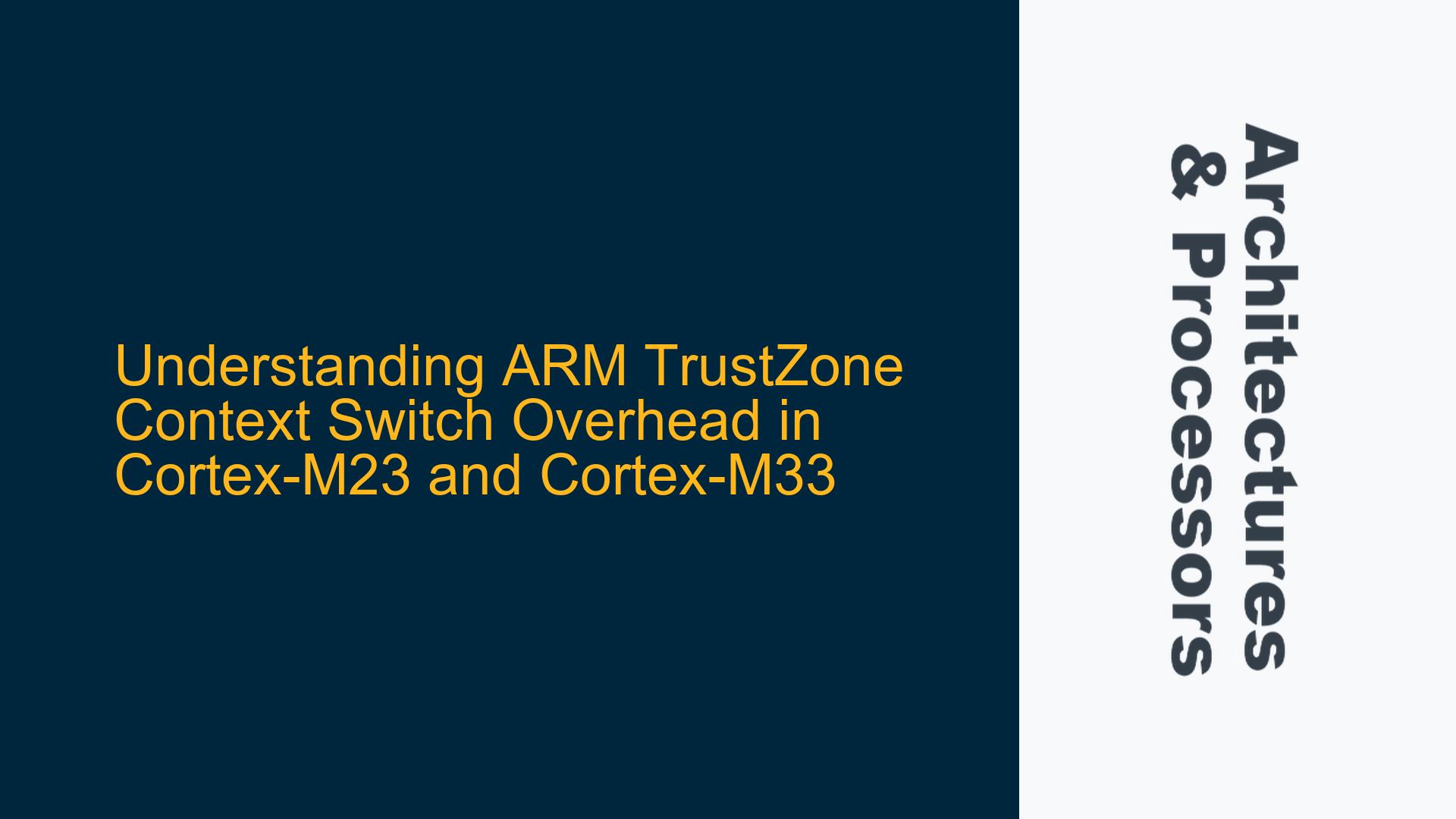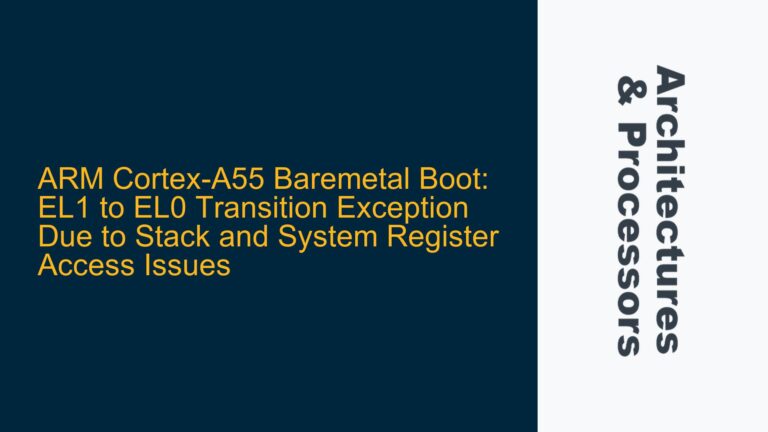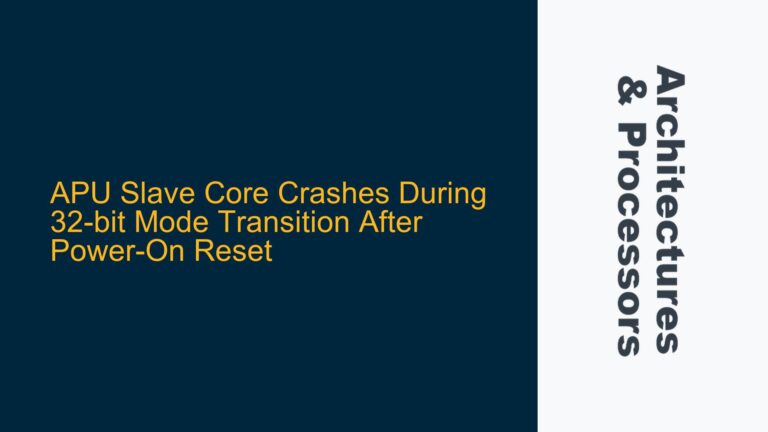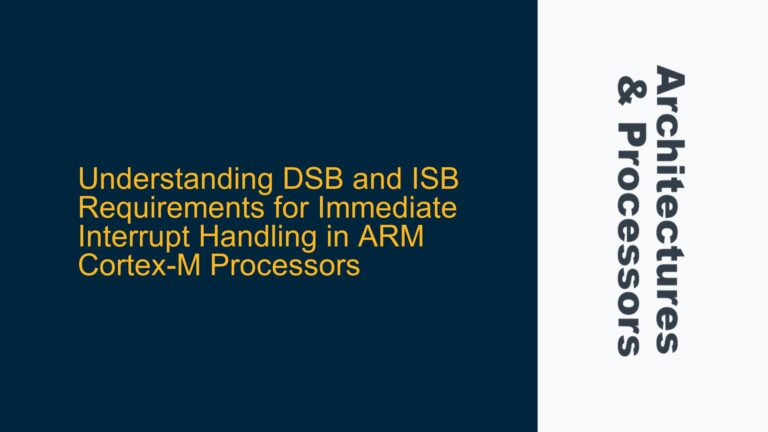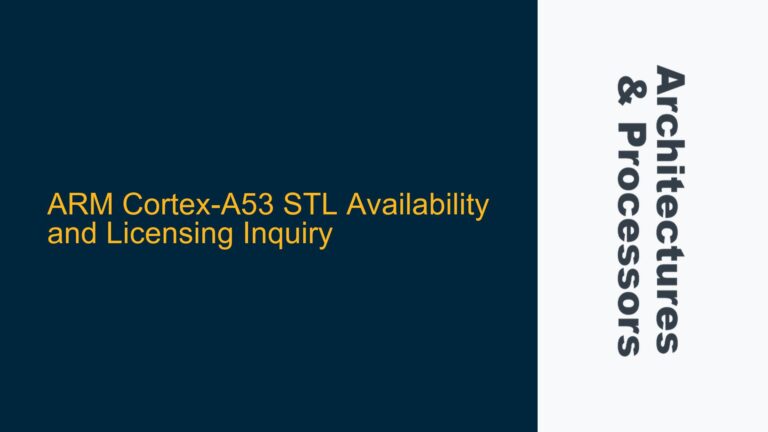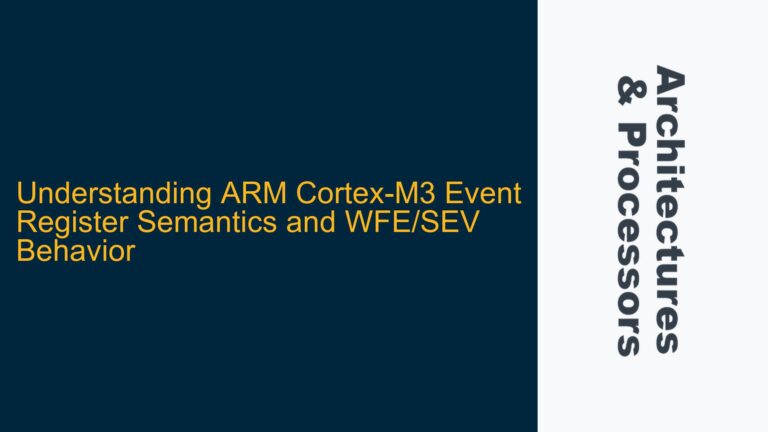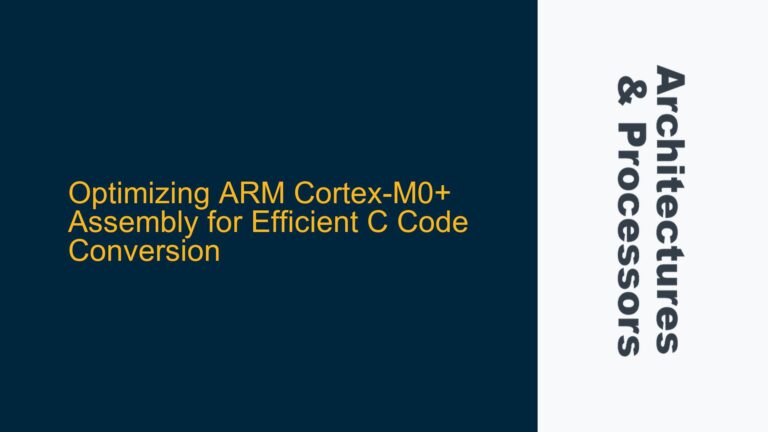ARM TrustZone Context Switch Overhead in Non-Secure and Secure Worlds
The ARM TrustZone technology introduces a hardware-based security feature that partitions the system into secure and non-secure worlds. This partitioning is crucial for isolating sensitive operations and data from non-secure applications. However, this isolation comes with an overhead, particularly during context switches between the secure and non-secure worlds. Understanding the clock cycle overhead for these context switches is essential for optimizing system performance, especially in real-time embedded systems where timing is critical.
In the context of ARM Cortex-M23 and Cortex-M33 processors, the overhead for context switching between non-secure threads, as well as between non-secure and secure threads, is influenced by several factors. These include the processor architecture, the specific implementation of the TrustZone technology, and the operating system (OS) being used. The Cortex-M23 and Cortex-M33 processors, while both supporting TrustZone, have different architectural features that can affect the context switch overhead.
The Cortex-M23 is based on the ARMv8-M baseline architecture, which is designed for ultra-low-power applications. It implements a subset of the ARMv8-M features, including the TrustZone security extension. The Cortex-M33, on the other hand, is based on the ARMv8-M mainline architecture, which includes additional features such as a Floating-Point Unit (FPU) and Digital Signal Processing (DSP) instructions. These differences can lead to variations in the context switch overhead between the two processors.
When a context switch occurs between non-secure threads, the processor must save the current thread’s context (including registers, program counter, and stack pointer) and restore the context of the next thread. In the case of a context switch between non-secure and secure threads, additional steps are required to ensure the security of the system. These steps include saving and restoring the secure context, which involves additional clock cycles.
The exact number of clock cycles required for these context switches can vary depending on the specific implementation and the OS. However, the Cortex-M23 Technical Reference Manual (TRM) provides some insight into the overhead. For example, the TRM states that the "Branch and Exchange Non-Secure" (BXNS) instruction, which is used to switch from the secure to the non-secure world, takes 4 clock cycles. This is just one component of the overall context switch overhead, which also includes the time required to save and restore the context, as well as any additional security checks that may be required.
In summary, the clock cycle overhead for context switching in ARM TrustZone-enabled processors like the Cortex-M23 and Cortex-M33 is influenced by several factors, including the processor architecture, the specific implementation of TrustZone, and the OS. Understanding these factors is crucial for optimizing system performance and ensuring that the security features do not introduce unacceptable latency.
Factors Influencing Context Switch Overhead in ARM TrustZone
The overhead associated with context switching in ARM TrustZone-enabled processors is influenced by several key factors. These factors include the processor architecture, the specific implementation of the TrustZone technology, the operating system (OS) being used, and the nature of the context switch (i.e., between non-secure threads or between non-secure and secure threads).
Processor Architecture
The ARM Cortex-M23 and Cortex-M33 processors, while both supporting TrustZone, have different architectural features that can affect the context switch overhead. The Cortex-M23 is based on the ARMv8-M baseline architecture, which is designed for ultra-low-power applications. It implements a subset of the ARMv8-M features, including the TrustZone security extension. The Cortex-M33, on the other hand, is based on the ARMv8-M mainline architecture, which includes additional features such as a Floating-Point Unit (FPU) and Digital Signal Processing (DSP) instructions. These differences can lead to variations in the context switch overhead between the two processors.
For example, the Cortex-M33’s FPU and DSP instructions can increase the context switch overhead when these features are used, as the processor must save and restore the additional state associated with these features. In contrast, the Cortex-M23, which lacks these features, may have a lower context switch overhead in scenarios where these features are not required.
TrustZone Implementation
The specific implementation of the TrustZone technology in the processor also plays a significant role in determining the context switch overhead. TrustZone introduces additional security checks and context management steps that must be performed during a context switch. These steps include saving and restoring the secure context, which involves additional clock cycles.
The Cortex-M23 Technical Reference Manual (TRM) provides some insight into the overhead associated with these steps. For example, the TRM states that the "Branch and Exchange Non-Secure" (BXNS) instruction, which is used to switch from the secure to the non-secure world, takes 4 clock cycles. This is just one component of the overall context switch overhead, which also includes the time required to save and restore the context, as well as any additional security checks that may be required.
Operating System
The operating system (OS) being used can also influence the context switch overhead. Different OSes may implement context switching in different ways, leading to variations in the overhead. For example, some OSes may optimize the context switch process by minimizing the number of registers that need to be saved and restored, while others may perform additional security checks that increase the overhead.
In the case of ARM TrustZone, the OS must also manage the secure and non-secure contexts, which can add to the complexity of the context switch process. The OS must ensure that the secure context is properly saved and restored during a context switch, and that any security checks are performed to prevent unauthorized access to the secure world.
Nature of the Context Switch
The nature of the context switch (i.e., between non-secure threads or between non-secure and secure threads) also affects the overhead. A context switch between non-secure threads typically involves saving and restoring the non-secure context, which includes the general-purpose registers, program counter, and stack pointer. In contrast, a context switch between non-secure and secure threads involves additional steps to save and restore the secure context, as well as any security checks that may be required.
The overhead for a context switch between non-secure and secure threads is generally higher than that for a context switch between non-secure threads, due to the additional steps involved in managing the secure context. However, the exact overhead can vary depending on the specific implementation and the OS.
In summary, the context switch overhead in ARM TrustZone-enabled processors is influenced by several factors, including the processor architecture, the specific implementation of TrustZone, the OS, and the nature of the context switch. Understanding these factors is crucial for optimizing system performance and ensuring that the security features do not introduce unacceptable latency.
Optimizing Context Switch Overhead in ARM TrustZone-Enabled Systems
Optimizing the context switch overhead in ARM TrustZone-enabled systems requires a thorough understanding of the factors that influence the overhead, as well as the specific requirements of the application. The following steps and solutions can help reduce the context switch overhead and improve system performance.
Minimizing Context Switch Frequency
One of the most effective ways to reduce the context switch overhead is to minimize the frequency of context switches. This can be achieved by optimizing the scheduling algorithm used by the OS to reduce the number of context switches required. For example, the OS can prioritize tasks that have similar security requirements, reducing the need for frequent switches between the secure and non-secure worlds.
Additionally, the application can be designed to minimize the number of transitions between the secure and non-secure worlds. For example, sensitive operations can be grouped together and executed in a single secure context, reducing the need for frequent context switches.
Optimizing Context Save and Restore Operations
The context save and restore operations are a significant contributor to the context switch overhead. Optimizing these operations can help reduce the overhead. One approach is to minimize the number of registers that need to be saved and restored during a context switch. For example, if certain registers are not used by the current task, they do not need to be saved and restored, reducing the overhead.
Another approach is to use hardware features that can accelerate the context save and restore operations. For example, some ARM processors include a "lazy stacking" feature that defers the saving of certain registers until they are actually used, reducing the overhead for context switches that do not require all registers to be saved.
Leveraging TrustZone Features
The ARM TrustZone technology includes several features that can help reduce the context switch overhead. For example, the "Secure Gateway" (SG) instruction can be used to transition from the non-secure to the secure world with minimal overhead. The SG instruction allows the processor to jump directly to a secure entry point, bypassing some of the security checks that would otherwise be required.
Additionally, the "Non-Secure Callable" (NSC) memory region can be used to allow non-secure code to call secure functions with minimal overhead. The NSC region is a special memory region that is accessible from both the secure and non-secure worlds, allowing secure functions to be called directly from non-secure code without the need for a full context switch.
Using Efficient Security Checks
Security checks are an essential part of the context switch process in ARM TrustZone-enabled systems, but they can also contribute to the overhead. Optimizing these checks can help reduce the overhead. For example, the OS can use efficient algorithms for checking the integrity of the secure context, reducing the time required for these checks.
Additionally, the OS can use hardware features that accelerate security checks. For example, some ARM processors include a "Memory Protection Unit" (MPU) that can be used to enforce security policies with minimal overhead. The MPU can be configured to restrict access to certain memory regions, reducing the need for additional security checks during a context switch.
Profiling and Benchmarking
Profiling and benchmarking the context switch overhead can help identify areas where optimization is needed. By measuring the overhead for different types of context switches, developers can identify the most significant contributors to the overhead and focus their optimization efforts on these areas.
For example, developers can use performance counters to measure the number of clock cycles required for different context switch operations. This information can be used to identify bottlenecks and optimize the context switch process.
Customizing the OS
In some cases, customizing the OS can help reduce the context switch overhead. For example, the OS can be modified to use more efficient algorithms for context switching, or to take advantage of specific hardware features that reduce the overhead.
Additionally, the OS can be configured to prioritize certain tasks or to use different scheduling algorithms that reduce the frequency of context switches. For example, the OS can be configured to use a "round-robin" scheduling algorithm that reduces the need for frequent context switches between tasks with similar security requirements.
Conclusion
Optimizing the context switch overhead in ARM TrustZone-enabled systems requires a thorough understanding of the factors that influence the overhead, as well as the specific requirements of the application. By minimizing the frequency of context switches, optimizing context save and restore operations, leveraging TrustZone features, using efficient security checks, profiling and benchmarking, and customizing the OS, developers can reduce the context switch overhead and improve system performance.
In summary, the clock cycle overhead for context switching in ARM TrustZone-enabled processors like the Cortex-M23 and Cortex-M33 is influenced by several factors, including the processor architecture, the specific implementation of TrustZone, and the OS. Understanding these factors is crucial for optimizing system performance and ensuring that the security features do not introduce unacceptable latency. By following the steps and solutions outlined above, developers can reduce the context switch overhead and improve the performance of their ARM TrustZone-enabled systems.
